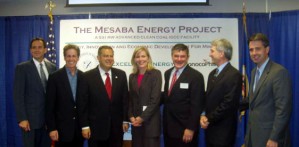Responses to Excelsior Energy articles in DNT
August 24th, 2011
For background on this Excelsior Energy scam known as the Mesaba Energy Project, just search on that link and here on Legalectric for Excelsior, Mesaba, gasification, boondoggle, etc.!!!!
If you search their site, what is most noticeable is the changes, lots is missing, for example, on their “About Us” page, their “Our Team” is missing a lot of people. Here’s what it used to say:
| Excelsior Energy | |
Excelsior’s executive team has significant utility and power plant experience including all of the following aspects of large energy projects, planning, development, engineering, financing, permitting, construction and operation.
Executive Team Julie Jorgensen Co-President and CEO Thomas Micheletti Co-President and CEO Thomas Osteraas Senior Vice President and General Counsel Dick Stone Senior Vice President, Development and Engineering Robert Evans Vice President, Environmental Affairs Kathi Micheletti Vice President, Government Relations William Ruzynski Vice President, Development Mary Day Controller
Additional Senior Personnel
The following senior industry experts work with Excelsior Energy on a regular basis
Stephen Sherner Sherner Power Consulting Bruce Browers Browers Consulting
It’s just a remnant of its former self.
Anyway, the Duluth News Tribune articles were published:
Millions in public money spent, but Iron Range power plant still just a dream
Iron Range energy project seeks lifeline in more funding, new fuel source
… and then came some responses, first from the paper’s editors standing up against this boondoggle (finally!), and then from Julie and Tom:
Published August 23, 2011, 12:02 AM
Our view: Taxpayers have right to answers on Excelsior
What happened to our more than $40 million?Even then, what was reported often was incomplete.
And, perhaps most pressing of all to taxpayers, what happened to our more than $40 million?
Here’s what Julie Jorgensen and Tom Micheletti had to say in response:
Published August 24, 2011, 12:00 AM
In response: Excelsior Energy project is an important energy option for state
By: Julie Jorgensen and Tom Micheletti, Duluth News TribuneThe Mesaba Energy Project, under development by Excelsior Energy, is a unique public/
We at Excelsior Energy take our obligations under our
The project is nearing the end of this complex governmental-
Julie Jorgensen and Tom Micheletti are co-CEOs of Excelsior Energy Inc.

Leave a Reply